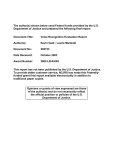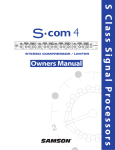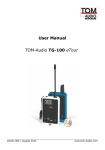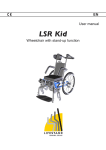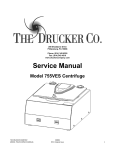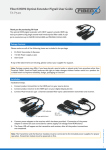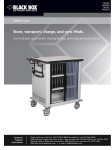Download Installation Instructions for M1A or M14 Rifles
Transcript
Installation Instructions for M1A or M14 Rifles Thank you for choosing SAGE! PLEASE NOTE SAGE M14/M1A EBR stocks are designed for Mil-Spec rifles. Fitting SAGE chassis to non-Mil-Spec rifles may require additional gunsmithing. SAGE is not responsible for any additional fitting that may be required. For Technical Support Call – (989) 739-7000 or email [email protected] M1A is a registered trademark of Springfield, Inc. SAGE INTERNATIONAL, LTD OSCODA, MI 2 989-739-7000 WWW.SAGEINTERNATIONALLTD.COM Safety Rules: Always keep the firearm pointed in a safe direction. Always keep your finger off the trigger until ready to fire. Always treat the firearm as if it were loaded. Always identify your target and what is beyond it. Getting ready: To safely and quickly disassemble the rifle you will need the following equipment: Eye protection-safety glasses Punch-1/8” diameter 3/8” open end wrench Brass or aluminum drift Small ball-peen hammer Gas cylinder lock wrench (provided by weapon mfg.) Allen wrenches - 1/16”, 1/8”, 3/16” Plastic or fiber non-marring hammer Flash suppressor pliers (provided by weapon mfg.) If you have or can procure a copy of the Department of the Army Technical Manual TM 9-1005-223-12, the process to install an M1A or M14 action into the Sage International, Ltd. Enhanced Battle Rifle Chassis system may be easier to follow. However, the manual is not absolutely necessary. Disassembling the M1A or M14 rifle with a GI chassis system: SPECIAL NOTE: The procedure set forth in these installation instructions refers specifically to M14 rifles manufactured to Military Standards. Certain commercially produced rifles may not embody all of the features of a Mil Spec produced M14 or do not assemble and disassemble the same way as a Mil Spec M14 rifle. Check the user’s manual that was provided with your rifle or contact the manufacturer of your rifle and also refer to those instructions. Remove the Trigger/Sear Mechanism: - Place the rifle on SAFE and remove the magazine. - Pull back the bolt to ensure the chamber is CLEAR. - Turn the rifle upside down or stand the rifle on its butt plate. - Disengage the hooked end of the trigger guard from the firing mechanism housing. - Swing the trigger guard away from the chassis system but do not rotate more than 90 degrees. - Care must be taken not to over rotate the trigger guard and to move the trigger guard in the same plane as the axis of the barrel toward the muzzle. - Remove the trigger/sear mechanism from the rifle. Remove the Chassis system with Butt Plate Assembly: Grasping the receiver firmly in one hand and by striking sharply on the chassis system butt with the palm of the other hand. - Lift the chassis system from the barrel and receiver group. - SAGE INTERNATIONAL, LTD OSCODA, MI 3 989-739-7000 WWW.SAGEINTERNATIONALLTD.COM Remove the Operating Rod Spring Guide, Operating Rod Spring and Operating Rod: - Turn the rifle upside down and rest it on the front and rear sight assembly. - Pull forward on the operating rod spring, relieving the pressure on the connector lock pin. Pull the lock outward to disconnect the operating rod spring guide and slowly detention the operating rod spring. - Remove the operating rod spring and the operating rod spring guide. - Turn the receiver group right side up. - Retract the operating rod until the key on its lower surface coincides with the notch in the receiver. Lift the operating rod free and pull to the rear disengaging it from the operating rod guide. - Remove the bolt assembly from the receiver. Removing the Flash Suppressor: (Note: SOCOM 16 owners - skip this step) - Using a 1/16” Allen wrench, remove the flash suppressor nut locking setscrew. - Using the special flash suppressor pliers insert the pliers teeth into two of the twelve opposing notches of the flash suppressor nut. - Squeeze the handles of the pliers and turn the flash suppressor nut counter clockwise until the nut is free and can be finger turned. - Continue turning the flash suppressor nut until it is free from the barrel threads. - Remove the flash suppressor by moving it straight out parallel with the axis of the bore of the rifle. Do not try to turn the flash suppressor as it is held upright by splines which interface in the barrel. If necessary, lightly tap the back of the flash suppressor with a brass or aluminum drift. Removing the Hand Guard Assembly: - Remove the gas cylinder plug form the gas cylinder. You may have to use a gas cylinder combination wrench or a 3/8” open-end wrench to break the plug free. - Remove the gas cylinder piston. Turning the rifle muzzle down on a padded surface and shaking the rifle accomplishes removal of the gas cylinder piston. The gas cylinder piston should fall out. - Unscrew gas cylinder lock. You may have to use a special figure 8 wrench to break the gas cylinder lock. Turn the gas cylinder lock counter clockwise to loosen it. - Slide the gas cylinder and front band forward. - Slide the hand guard assembly forward and remove from the barrel. Remove the Gas Cylinder Assembly and Front Band: The gas cylinder assembly and front band are now loose. Refer to “Removing the Hand Guard Assembly.” - Slide the gas cylinder assembly and front band forward toward the muzzle and off the end of the barrel. If the gas cylinder is stuck in place it may be necessary to lightly tap the back of the gas cylinder with a brass or aluminum drift. Care must be taken not to dent or change the shape of the gas cylinder assembly. - Once the gas cylinder assembly has been removed, the front band will be exposed. Remove the front band because you will no longer need it. - Remove the Operating Rod Guide Block: - The operating rod guide block is held in place by two methods; a roll or spring pin and a press fit of the block on the barrel. - To remove the spring pin, take a 1/8” punch and drive the spring or roll pin completely out of the block. Retain the pin to assemble the rifle back to its original configuration or it can be used with the new operating rod guide block, it is optional. SAGE INTERNATIONAL, LTD OSCODA, MI 4 989-739-7000 WWW.SAGEINTERNATIONALLTD.COM Continued…Remove the Operating Rod Guide Block - To remove the operating rod guide block move it toward the muzzle along the axis of the bore. If you cannot move the block by hand it may be necessary to lightly tap the back of the operating rod guide block with a brass or aluminum drift. - You have now disassembled the rifle to where the M14 barreled action can be reassembled into the Sage International, Ltd., Enhanced Battle Rifle Chassis system. Before beginning, you may want to take the opportunity to thoroughly clean the parts and surfaces, which are not normally available to you before you begin. Reassembling the M1A or M14 rifle with the Sage International, Ltd. Enhanced Battle Rifle (EBR) Chassis system Inventorying the EBR Chassis system components. Each EBR Chassis system should come equipped with the following components: Chassis system which includes the following components assembled to the chassis: Two (2) 6” 1913 Picatinny rails @ the 3 and 9 o’clock position with mounting screws (2 ea. 10-24 x 3/8” BHCS). One (1) 12” Picatinny rail @ the 6 o’clock position with mounting screws (5 ea. ¼-20 x 3/8” BHCS). Collapsible Chassis system assembly-certain configurations may not be collapsible with a pistol grip or may be a straight fixed grip configuration-due to Federal and State Laws. KYDEX palm swelled front grip and screws. (2 ¼”-20 x ½” BHCS) Three (3) sling point assemblies with mounting hardware located at the rear of the collapsible chassis system, at the union of the collapsible chassis system and at a position on the fore-end of the chassis with several ambidextrous mounting locations. Hand guard Assembly with integral 1913 Picatinny rail and mounting screws (6 ea. 10-24 x 3/8 for Standard Military Top or 5 ea. 10-24 x 3/8 for Medium/Heavy Commercial Tops). Operating rod guide block with mounting screws (3 ea. ¼-28 x 1/2” BHCS). One (1) crush washer that replaces space taken up by the front band of the hand guard assembly. Installing the EBR Operating Rod Guide Block: Op Rod Guide blocks for the heavy wt. barrel chassis require only two bolts. Older models use only one bolt. - The EBR operating rod guide block differs from the original operating rod guide block in-as-much as it is designed to lock down the barrel and create a free float of the barrel forward of the block. The EBR block will be shipped in its installed location. When removing the EBR block note the location and length of each button head cap screw (3 ea). Also note that the EBR operating rod guide block has a red orientation mark facing the target or the end of the barrel. The EBR operating rod guide block must be reinstalled in this orientation. - With the EBR operating rod guide block oriented with the red dot facing the muzzle, slide the EBR operating rod guide block on to the barrel. The EBR operating rod guide block may slide on to the barrel location allotted for the block or it may have to be gently tapped into place using the aluminum or brass drift. The EBR operating rod guide is manufactured to the Mil Spec drawings. - OTIONAL-You may install the 1/8” spring or roll pin, which you removed from the operating rod guide block. Since the EBR operating rod guide block will be screwed into the aluminum chassis it is not necessary to reinsert the spring or roll pin. - SAGE INTERNATIONAL, LTD OSCODA, MI 5 989-739-7000 WWW.SAGEINTERNATIONALLTD.COM Installing the Crush Washer (Replacement for the Hand Guard Assembly Front Band): - Slide the special crush washer on to the barrel (orienting the wider part of crush washer towards the receiver) and back to the machined shoulder on the barrel replacing the front band of the hand guard assembly. Refer to “Removing the Hand Guard Assembly.” The front band is no longer needed. However, the position of the gas cylinder assembly is made by the thickness of the front band. The crush washer duplicates the correct thickness of the front band and correctly positions the gas cylinder assembly. Installing the Gas Cylinder Assembly, Gas Cylinder Lock, Gas Cylinder Piston and the Gas Cylinder Plug: - Install the gas cylinder assembly by sliding it on to the barrel, it too is aligned by splines on the inside of the gas cylinder assembly and matching grooves in the barrel. Be sure that the gas cylinder assembly is tight against the or crush washer. - Screw on the gas cylinder lock. Tighten so that the gas cylinder lock is oriented in the 12 and 6 o’clock plane and tight against the gas cylinder assembly. - Install the gas cylinder piston. The gas cylinder piston has a flat surface machined on the area behind the actual piston portion. This surface aligns the gas cylinder piston in the gas cylinder assembly. Insert the machined portion of the gas cylinder piston first into the gas cylinder assembly. Be sure to check the orientation and that the gas cylinder piston is setting deep enough within the gas cylinder assembly. - Screw on the gas cylinder plug finger tight. If the gas cylinder plug does not screw down tight against the gas cylinder assembly check to see that the gas cylinder piston is seated correctly. Once the gas cylinder plug is in position, tight against the gas cylinder assembly, tighten the gas cylinder plug with the 3/8” open end wrench. DO NOT OVERTIGHTEN. Installing the Bolt Assembly, Operating Rod, Operating Rod Spring and the Operating Rod Spring Guide: - Install the bolt assembly into the receiver. - Install the round portion of the operating rod in the operating rod guide. - Place the recessed section of the operating rod over the roller on the bolt; line up the key on the lower surface with the notch in the receiver and push the rod forward. - Turn the receiver and barrel assembly upside down. - Install the operating rod spring into the operating rod and the operating rod spring guide into the spring; CAUTION-compress the spring and set the operating rod spring guide into the slot of the receiver. Secure in place by engaging the connector lock in the slot at the rear of the operating rod spring guide by pushing the connector lock inward. - Cycle the operating rod several times to insure it moves freely and functions smoothly. Installing the Receiver and Barrel Assembly into the EBR Chassis: - Take the entire receiver and barrel assembly with operating rod block and fit it into the EBR Chassis system chassis. It will be a tight fit. Gentle tapping with a plastic or fiber non-marring hammer may be necessary. - Making sure the receiver is fully down into the chassis align the EBR operating rod block with the proper screw holes in the chassis. Insert the three button head cap screws into the EBR operating rod block. Snug but do not fully tighten. - Check the receiver and make sure that it is setting down on the rear of the EBR chassis. - With the trigger guard in its open position insert the trigger/firing mechanism into the rifle. Close the trigger guard. A slight resistance should be felt when closing the trigger guard. - Using a torque wrench tighten the three screws on the operating rod block with a 3/16” Allen wrench to 25-30 inch-pounds. SAGE INTERNATIONAL, LTD OSCODA, MI 6 989-739-7000 WWW.SAGEINTERNATIONALLTD.COM Installing the Flash Suppressor with Front Sight: - Insert the round serrated nut into the flash suppressor and slide the flash suppressor on to the barrel aligning the splines on the barrel with the slots in the body of the flash suppressor. - Finger tighten the serrated nut. - Using the special flash suppressor pliers rotate the serrated nut clockwise until fully tightened. - Tighten the setscrew at the base of the front sight and on the body of the flash suppressor with the 1/16” Allen wrench. DO NOT OVER TIGHTEN. Installing the Hand Guard Assembly with Integral 1913 Picatinny Rail: - Set the hand guard assembly on top of the chassis assembly. You will see five (5) or six (6) corresponding tapped holes, which accept five or six socket head cap screws. Make sure the hand guard assembly is setting flat on the chassis assembly. - Insert the 10-24 x ½ socket head cap screws into the hand guard assembly. Tighten all five or six to contact. Working from corner to the opposite corner snug the screws with a 1/8” Allen wrench. - Using a torque wrench, tighten each screw to 22-25 inch-pounds, again working from corner to opposite corner. Congratulations, you have completed the installation of your M1A or M14 rifle barreled action into the Sage International, Ltd., Enhanced Battle Rifle (EBR) Chassis system. From the information we have received and the results we have experienced, your accuracy should increase. Remember the acceptance specification from Springfield Armory, Springfield, MA for the original M14 rifle was 7” at 100 yards. Should you encounter any problems or have any questions, please feel free to contact us. SAGE INTERNATIONAL, LTD. 3455 KINGS CORNER ROAD OSCODA, MI 48750 06-2013 SAGE INTERNATIONAL, LTD OSCODA, MI 7 989-739-7000 WWW.SAGEINTERNATIONALLTD.COM







